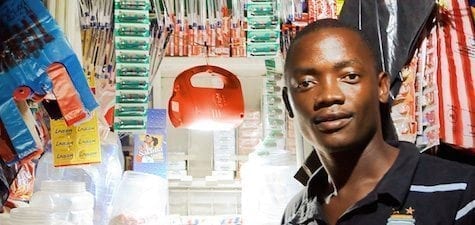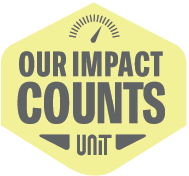How to Empower 50 Million: A Lesson in Agility From d.light
By Alison Klein | May 27, 2015
Have you heard of the butterfly effect? Coined by mathematician Edward Lorenz, the term refers to the idea that something as small as the beating of a butterfly’s wings can alter the course of a hurricane.
It’s the idea that little changes now can make a big difference later.
When d.light Product Manager Jacob Lewandowski told me the story of d.light’s mission and impact, I was intrigued by what I can only dub a double-butterfly effect – a situation where the agent for change is itself changed.
Read on to learn more about how d.light has transformed the way 49 million people use and pay for energy and, in the process, experienced its own transformation.
Sign Up for Pegable Post to get ideas, advice and resources on activating your Purpose sent right to your inbox.
A Small Change
 d.light is a B Corp that sells affordable solar energy solutions to people all over the world. Anyone can buy the products, but they are designed primarily to allow those without access to reliable energy to light their homes and charge small devices like cell phones.
d.light is a B Corp that sells affordable solar energy solutions to people all over the world. Anyone can buy the products, but they are designed primarily to allow those without access to reliable energy to light their homes and charge small devices like cell phones.
At first I didn’t quite grasp the transformative power of affordable solar energy, so Jacob shed some light on the topic.
Those living off-grid traditionally use oil lamps fueled by kerosene. When burned, kerosene releases several nasty byproducts including carbon monoxide. In low concentrations, carbon monoxide can cause headaches, dizziness and nausea; in high concentrations it can kill.
In addition to exposing users to toxic fumes, kerosene lamps also put them at risk for fire and require them to constantly purchase more fuel. Essentially, using a kerosene lamp means paying for every second of light while breathing harmful gases and risking bodily injury.
Those who use d.light’s products have a very different experience. After the initial purchase, they can enjoy a light that’s 3-10 times brighter free of charge for the life of the product (around 5 years). This allows them to recover money they would have spent on oil and apply it toward other pressing needs.
A Bigger Impact
d.light’s business model has also created opportunities for people all along its supply chain. As Jacob put it, “We believe in empowering local partners including importers, retailers and enterprising local people who want to use their personal time to bring value to their communities.”
To this end, d.light provides would-be-entrepreneurs with demo models and sales and marketing materials. They’ll also pair entrepreneurs with existing retailers so they can borrow and sell the store’s stock instead of fronting the money to acquire their own.
When I tried to understand more about this supply chain, I really started to see the double-butterfly effect in action.
Transformation Goes Both Ways
It seemed like every time I tried to summarize how their supply chain works, Jacob responded with the caveat: “In some places that’s the case.” The reality is that d.light significantly alters its operations and strategy to fit the needs of different markets. They listen before they act and let what they hear determine their course of action.
For example, d.light has developed a variety of payment options to allow more people to obtain robust solar energy systems. In some markets third-party businesses will finance microloans and set up lease-to-own programs. In others, these third-party lenders administer pay-by-consumption programs that include product maintenance.
In other places, d.light accepts payments directly. Depending on their location and available options, users can pay via cellular phone, with cash at a store, or through employer sponsored plans or savings groups.
d.light also offers different support options for different markets. Part of Jacob’s job as a product manager is to determine how people in different markets want customer support and information. Do they want “a local language Facebook page? Do they want to be able to request technical support through an SMS message? Through a phone call?” Each market has different wants, needs and expectations and d.light has allowed these variations to drive, rather than impede, its path forward.
According to Jacob, this understanding makes the introduction of the products plausible and successful. “We try to partner with locals who understand their market, neighborhood, village… I think much of our success is due to our ability to humbly listen to our customers and partners and to adjust our strategy accordingly.
Future Changes
 d.light is unique in that its target market has been bottom-of-the-pyramid (BOP) consumers from the beginning. This gives them a different perspective than “companies that build products, succeed in the west then adapt them to appeal to BOP consumers.” Instead of starting with a just a product, d.light started with a product and a mission to get it to those in need. The mission lends itself to flexibility, as does the fact that they’re upending the status quo of energy consumption: there’s no template when you’re breaking new ground.
d.light is unique in that its target market has been bottom-of-the-pyramid (BOP) consumers from the beginning. This gives them a different perspective than “companies that build products, succeed in the west then adapt them to appeal to BOP consumers.” Instead of starting with a just a product, d.light started with a product and a mission to get it to those in need. The mission lends itself to flexibility, as does the fact that they’re upending the status quo of energy consumption: there’s no template when you’re breaking new ground.
Jacob feels that different businesses and nonprofits can learn from d.light’s findings. Often, “We try to prescribe a solution in terms of international development or aid — coming down with an understanding of how things should be done. With that comes an assumption that people who are poor aren’t equipped to make decisions for their livelihood.”
In reality, Jacob explains: “many of these people are incredibly shrewd financially since they have to stretch resources. They weigh every purchasing decision carefully.” To really make change, we need to give them information and then let them make their own decisions, like any other consumers.
Through their work, d.light is proving that the world’s poorest people are willing – and able – to pay for the products that will improve their lives. They’re also teaching other businesses a valuable lesson: when entering a new market, it’s best to learn, not prescribe. You might be surprised at the changes that ensue!
Have you ever adjusted your operations to better serve a new market? Maybe you made changes to do better by those you’re already serving? I’d love to hear how your customers have changed your business in the comments below.
The Company Crush series spotlights companies using inventive business models to create positive change in the world. By sharing their stories, we hope to inspire more people to use business as a force for good.



